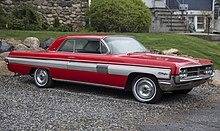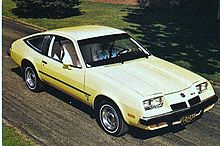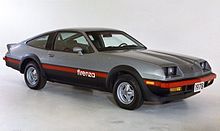Oldsmobile Starfire
| Oldsmobile Starfire | |
|---|---|
Subcompact (1975–1980) |
The Oldsmobile Starfire is an automobile
Oldsmobile during this time period was one of the most popular brands selling, and the company saw an opportunity to benefit from the
After a two-year hiatus the Starfire name returned for 1961 as a separate model, offered in a single convertible
The Starfire nameplate returned for the 1975 model year as Oldsmobile's first subcompact, powered by a Buick V6 engine. The 1977 Starfire featured a four-cylinder engine as standard equipment, for the first time since the 1922 Model 43. Production ceased in 1980.
Concept car (1953)
| Oldsmobile Starfire | |
|---|---|
| Overview | |
Curb weight | 4,453 lb (2,020 kg) |
The Starfire name was first used by Oldsmobile on a one-of-a-kind
Later in 1953, the luxury, limited-production 98 Fiesta convertible, Spanish for "festival", or "party", offered some of the features on the Starfire concept car and was a top trim package for the Oldsmobile 98. Some of the new features added were a 12-volt electrical system that could power comfort and convenience features like electrically powered window lifts, convertible tops and front seat power adjustment. The engine was the 303 cu in (5.0 L) installed with the "Quadri-Jet" 4-barrel carburetor. The overall appearance was similar to the concept car while showing some similarities to the Cadillac Eldorado.[1]
Mechanically, the Fiesta had a special version of the Ninety-Eight engine which gained 5 horsepower to 170 hp (130 kW) through manifold streamlining and compression increased from 8.1:1 to 8.3:1. A four speed Hydramatic automatic transmission and faster rear axle rato were designed to keep the 4453 pound shipping weight Fiesta (336 more than a standard Ninety-Eight convertible) up to Oldsmobile performance standards. At US$5,715 ($65,083 in 2023 dollars [3]) (over $700 ($7,972 in 2023 dollars [3]) more than the Buick Roadmaster Skylark) the 98 Fiesta was nearly twice the US$2963 price ($33,743 in 2023 dollars [3]) of a standard Ninety-Eight convertible, with only 458 units produced to its 7,521.[1] It was comparable in price to the 1953 Packard Caribbean with a similar retail price.[1]
-
1953 Starfire show car at theWaldorf Astoria
-
1953 98 Fiesta convertible
98 Starfire (1954–1957)
| 98 Starfire | |
|---|---|
| Overview | |
Curb weight | 4,193 lb (1,902 kg) |
The name was then used for the 1954–1956 model years to designate the luxury convertible models of the 98 DeLuxe line in much the same way that the Holiday name was used to designate hardtop body-styles. The 1954–1956 Oldsmobile 98 Starfire convertibles were the most expensive Oldsmobiles offered during those years with a retail price of US$3,249 ($36,862 in 2023 dollars [3]) and production records show 6,800 rolled off the assembly line for 1954. The 1955 model benefited from a 200bhp engine offering dual exhausts. Optional equipment included tinted glass, power adjustable front seat, signal seeking AM radio, leather upholstery, electric window lifts, power steering and power brakes. The price remained the most expensive at US$3,276 ($37,261 in 2023 dollars [3]) and production showed 9,149 were manufactured.[1]
The 1956 models were updated to the appearance offered on the concept car, with the most noticeable aspect of the appearance being the large gaping grille with minimal adornment and bumper guard elements. The automatic transmission became standard with the inclusion of a "park" position on the transmission gear selector. During the 1957 model year, all 98 models were referred to as Starfire 98,[4] sharing the standard features with the coupes and sedans. The name was dropped from the 98 series beginning with the 1958 model year.[1]
-
1955 98 Starfire convertible
-
1957 Oldsmobile Starfire 98 Holiday Coupe
First generation (1961–1966)
| First generation | ||
|---|---|---|
Curb weight | 4,305–4,492 lb (1,953–2,038 kg) | |
1961

Introduced in January 1961, the Starfire was a performance-oriented
1962

For the 1962 model year, the convertible was joined by a two-door hardtop, which featured a new convertible-styled roofline shared with other Oldsmobile 88 coupes. Horsepower was increased to 345 hp (257 kW). 1962 was the best sales year for this generation Starfire, with sales of the hardtop coupe being 34,839 and sales of the convertible being 7,149.[13]
1963

Styling changes for the 1963 model year included a move away from the sculpted sides of the previous years model, to a flatter, more conventional look with an exclusive squared off roofline that included a concave rear window. Sales of the coupe were down to 21,489 and the convertible was down to 4,401,[14] a drop of 38%.[14]
1964

The 1964 model appeared very similar to the 1963. Curb weight was down, but overall length was up to 215.3 inches (5,468.6 mm). Sales dropped further, to 13,753 coupes (down 36%) and 2,410 convertibles (down 45%).[15] The Starfire now shared its basic bodyshell with the new and lower-priced Jetstar I hardtop coupe which competed directly against the Pontiac Grand Prix. The Jetstar also used the Starfire's 345 hp (257 kW) 394 cu in (6.5 L) "Ultra High Compression" Rocket V8, but had a pricetag that was over $500[16] lower than the Starfire due to the use of a vinyl bucket seat interior and the fact that many Starfire standard features were optional on the Jetstar including Hydra-Matic transmission, power steering and brakes. Front seat belts were now standard.[17]
1965


For the 1965 model year, all Oldsmobiles would receive new styling, and the Starfire Coupe would receive a modified version of the 1963–1964 unique roofline with an inversely curved rear window. The Hardtop Sports Coupe body-style was again shared with the Jetstar I. Other 88 models adopted a Holiday Hardtop Coupe body-style that featured more of a fastback roof design, while the Ninety-Eight featured a more squared-off formal roof-line. A new version of the Rocket V8 engine was offered for the 1965 model year, this one measuring 425 cu in (7.0 L) displacement, still using a
1965 sales were 13,024 for the coupe and 2,236 for the convertible.[18]
1966
In 1966 only the Starfire coupe was offered, as the convertible was discontinued. The Starfire was moved downmarket and priced like the former Jetstar I. Equipment level dropped from previous years, with leather seats being replaced by Morroceen vinyl for both the Strato bucket seats or no-cost optional notchback bench seat, and no longer standard power windows and power seats. The Turbo Hydra-Matic transmission, power steering and power brakes also went to the optional equipment list. While the 425 V8 still produced 375 hp (280 kW; 380 PS), the Starfire no longer had the most powerful engine offered for sale in an Oldsmobile, as the Toronado had a similar engine offering 385 hp (287 kW; 390 PS). Sales of the 1966 Starfire Coupe were 13,019.[19]
1967
For 1967 the Starfire was discontinued, and in its place Oldsmobile offered a new upmarket version of the
nearly unchanged from the 1966 Starfire, it had similar interior trimmings and even carried the trademark brushed side trim with faux vents on the front fender. The two-door Holiday Coupe hardtop was complemented by a four-door Holiday Sedan, with the notchback bench seat.Second generation (1975–1980)
| Second generation | ||
|---|---|---|
Curb weight 2,800 lb (1,300 kg) | | |
| Chronology | ||
| Successor | Oldsmobile Firenza | |
The second-generation Oldsmobile Starfire is a
The Starfire was Oldsmobile's entry-level product and a




The Starfire has a 97.0-inch (2,460 mm) wheelbase and a 65.4-inch (1,660 mm) width. The Starfire,
The front suspension is short and long control arms with
1976 models could be had with the new optional Borg-Warner 5-speed manual with overdrive transmission. Starting with the 1976 models the front disc rotors were of the vented type.[23]
For the 1977 model year, the front end was revised with a split grille design with vertical slots similar to the previous year's Cutlass base models. The 140 CID (2.3-liter) aluminum-block inline 4-cylinder engine with 2-barrel carburetor became standard, while the
The 1978 standard engine was Pontiac's 151 CID (2.5-liter)
The 1979 model year saw a face lift, with twin rectangular headlamps replacing the previous quad rectangular headlamp design. The rear end was revised with a blunt rear body panel containing new taillamps and the license plate mounted above a conventional rear bumper. The V8 engine option was dropped at the end of the 1979 model year, as was the 5-speed manual transmission.[26]
The 1980 model year was the last one for the Starfire and its derivatives. Production ceased December 21, 1979, as Oldsmobile traded H-body production to Chevrolet and Pontiac in exchange for a higher allotment of new FWD X-bodies.[27]
The rear-wheel-drive H-body cars including the Starfire were replaced in the spring of 1981 with the new front-wheel drive
A total 125,188 H-body Starfires were produced in six model years.[28]
See also
- GM H platform (RWD)
- GM 2300 engine
- Chevrolet Vega
References
- ^ ISBN 978-0-7864-3229-5.
- ^ 1961 Oldsmobile Starfire Commercial
- ^ a b c d e f g 1634–1699: McCusker, J. J. (1997). How Much Is That in Real Money? A Historical Price Index for Use as a Deflator of Money Values in the Economy of the United States: Addenda et Corrigenda (PDF). American Antiquarian Society. 1700–1799: McCusker, J. J. (1992). How Much Is That in Real Money? A Historical Price Index for Use as a Deflator of Money Values in the Economy of the United States (PDF). American Antiquarian Society. 1800–present: Federal Reserve Bank of Minneapolis. "Consumer Price Index (estimate) 1800–". Retrieved February 29, 2024.
- ^ '57 Oldsmobile brochure, xr793.com Retrieved 15 May 2023
- ^ Dino Chemello. "1963 Oldsmobile Starfire".
- ^ ISBN 9781135518684.; sustained high-speed motoring from relatively modest engine size and compact closed coachwork
A newer concept altogether is the modern "Gran Turismo" class, which was in effect unknown before World War II
- ^ ISBN 9781845840600. Retrieved 16 May 2014.
- ^ a b "Directory Index: Oldsmobile/1964 Oldsmobile/album_001". Oldcarbrochures.com. Archived from the original on 2013-01-31. Retrieved 2011-11-20.
- ^ "Directory Index: Oldsmobile/1962 Oldsmobile/1962_Oldsmobile_Full_Line_Brochure". Oldcarbrochures.com. Retrieved 2022-08-18.
- ^ "Made in Japan". California. 7 (5–8): 129. 1982. Retrieved 6 December 2015.
- ^ ISBN 0-87341-027-0.
- ^ "Directory Index: Oldsmobile/1961 Oldsmobile/Album_003". Archived from the original on 2012-01-25. Retrieved 2012-06-23.
- ^ Flory, J. "Kelly", Jr. American Cars 1960-1972 (Jefferson, NC: McFarland & Coy, 2004), p.183.
- ^ a b Flory, p.249.
- ^ Flory, p.318.
- ^ Flory, pp.316 & 318.
- ^ "Directory Index: Oldsmobile/1964 Oldsmobile/1964_Oldsmobile_Prestige_Brochure". Oldcarbrochures.com. Retrieved 2022-08-18.
- ^ Flory, p.389.
- ^ Flory, p.467.
- ^ Flory, p.542.
- ^ h-body.org
- ^ 1975 Starfire brochure
- ^ 1976 Starfire brochure
- ^ 1977 Starfire brochure
- ^ 1978 Starfire brochure
- ^ 1979 Starfire brochure
- ^ Ward's Automotive Yearbook 1980. Ward's Communications, Inc. 1980.
- ^ H-Body.org
Sources
- Flammang, James M. & Kowlake, Ron, Standard Catalog of American Cars: 1976-199, 3rd Edition (Iola, WI: Krause Publications, 1999)




